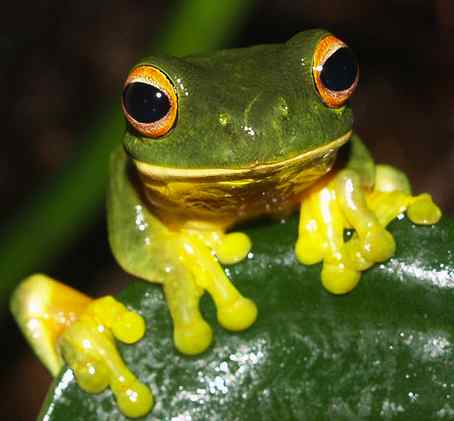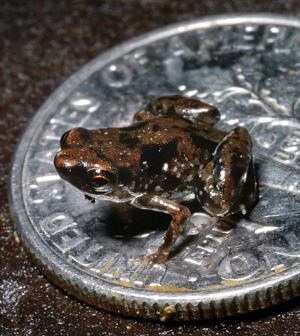 You may have heard that frogs are in trouble, with about a third of the world’s species currently threatened by a disease called chytrid fungus. But you might not know that you can easily help.
You may have heard that frogs are in trouble, with about a third of the world’s species currently threatened by a disease called chytrid fungus. But you might not know that you can easily help.
FrogWatch USA helps scientists collect data by using volunteers to count these amphibians. You can do it even if you live in a big city, and kids can participate too.
The problems began in the 1980’s and were so widespread that researchers realized they’d need a lot of data — and there weren’t enough scientists to go around. That’s why the FrogWatch program was started. “It was recognized that having lots of different people out there collecting data… would really make a difference,” says Rachel Gauza, FrogWatch USA national coordinator at the Association of Zoos & Aquariums.
What Does a Frog Watcher Do? They Listen.
Why not count actual frogs? One reason is that it’s often a lot easier to hear them than to see them.
“Some of our smallest species can put out some really impressive calls,” says Gauza. “One of the most highly reported species on the East Coast is the spring peeper. They’re so little they could sit on a quarter, but they put out this really high-pitched loud peep and they’re in these large aggregations tucked down into vegetation— it can be deafening.”
 Another reason is that when you listen, you don’t have to actually enter the habitat, says Gauza: “It’s nice because it’s not invasive. You can collect the data without disturbing things.” There’s no risk of interfering in the breeding process or spreading disease, which is especially important because one of the strains of the chytrid disease is thought to have originally been introduced by humans from frogs in the pet trade and medical industry.
Another reason is that when you listen, you don’t have to actually enter the habitat, says Gauza: “It’s nice because it’s not invasive. You can collect the data without disturbing things.” There’s no risk of interfering in the breeding process or spreading disease, which is especially important because one of the strains of the chytrid disease is thought to have originally been introduced by humans from frogs in the pet trade and medical industry.
And for some species of frogs, listening can be more accurate than looking, as one recent scientific discovery showed. A new species of leopard frog in Staten Island was discovered because a researcher heard an unfamiliar call. Although the frog sounded different, it was so similar in appearance to other species in the area that DNA testing was needed to confirm that it was a distinct species.
From Wetlands to Your Backyard
That discovery also shows there are frogs to be found even in the biggest city, and there are several sites in New York City that are monitored by FrogWatch volunteers. Frog habitat is not always pristine wilderness. “It doesn’t always have to be this natural, beautiful wetland,” says Gauza. “In many cases, stormwater ponds are the only available amphibian habitat there is. If that’s what they have, that’s what they’ll use. It could be right in your backyard or a neighborhood park or at the end of your cul-de-sac where the stormwater collects.”
Frogs also breed in spots where most of the year you don’t even see water. Places where water collects only in the spring, called vernal pools, are actually excellent frog habitat, since fish can’t survive to compete with the tadpoles.
Nalini Mohan of the Bronx Zoo trains some of the volunteers in New York, and says that FrogWatch is a great way to expose kids to nature and science. “Children are really good at distinguishing the frog calls, sometimes even better than adults,” she says.
 The data is collected with measurements that are very specific and simple, she says, and there’s training for all of it, both frog calls and the weather data that volunteers record. “They do a lot of activities to learn the calls,” she says, “and we bring a fan and show them the different windspeeds.” Because the data is collected at night, it’s a great activity for families and scout troops.
The data is collected with measurements that are very specific and simple, she says, and there’s training for all of it, both frog calls and the weather data that volunteers record. “They do a lot of activities to learn the calls,” she says, “and we bring a fan and show them the different windspeeds.” Because the data is collected at night, it’s a great activity for families and scout troops.
You can find training sessions at the FrogWatch website. If you’re not sure about participating, Gauza says, “we encourage people who are just interested in learning about frogs and toads to go.”
“It really opens people’s eyes to what is around,” says Mohan. “Frogs are really good ambassadors for wildlife.”‘
(MORE at FrogWatch USA)
Vetstreet.com is a pet website written by top veterinarians, pet health experts and journalists
dedicated to giving you the accurate information for keeping your dogs and cats healthy.
One Woman’s Mission: Turning Sloths Into Superstars to Save Their Lives
8 Zoos Helping Animals Edge Out of Extinction



















